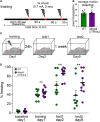Disrupting interaction between miR-132 and Mmp9 3'UTR improves synaptic plasticity and memory in mice
- PMID: 35992198
- PMCID: PMC9389266
- DOI: 10.3389/fnmol.2022.924534
Disrupting interaction between miR-132 and Mmp9 3'UTR improves synaptic plasticity and memory in mice
Abstract
As microRNAs have emerged to be important regulators of molecular events occurring at the synapses, the new questions about their regulatory effect on the behavior have araised. In the present study, we show for the first time that the dysregulated specific targeting of miR132 to Mmp9 mRNA in the mouse brain results in the increased level of Mmp9 protein, which affects synaptic plasticity and has an effect on memory formation. Our data points at the importance of complex and precise regulation of the Mmp9 level by miR132 in the brain.
Keywords: Mmp9; behavior; brain; miR132; microRNA; synaptic plasticity.
Copyright © 2022 Kuzniewska, Rejmak, Nowacka, Ziółkowska, Milek, Magnowska, Gruchota, Gewartowska, Borsuk, Salamian, Dziembowski, Radwanska and Dziembowska.
Conflict of interest statement
The authors declare that the research was conducted in the absence of any commercial or financial relationships that could be construed as a potential conflict of interest.
Figures





Similar articles
-
A functional polymorphism at miR‑491‑5p binding site in the 3'UTR of MMP9 gene confers increased risk for pressure ulcers after hip fracture.Oncol Rep. 2018 Jun;39(6):2695-2702. doi: 10.3892/or.2018.6338. Epub 2018 Mar 28. Oncol Rep. 2018. PMID: 29620239
-
The Brain-Enriched MicroRNA miR-9-3p Regulates Synaptic Plasticity and Memory.J Neurosci. 2016 Aug 17;36(33):8641-52. doi: 10.1523/JNEUROSCI.0630-16.2016. J Neurosci. 2016. PMID: 27535911 Free PMC article.
-
MicroRNA regulation of the synaptic plasticity-related gene Arc.PLoS One. 2012;7(7):e41688. doi: 10.1371/journal.pone.0041688. Epub 2012 Jul 26. PLoS One. 2012. PMID: 22844515 Free PMC article.
-
MicroRNA regulation of homeostatic synaptic plasticity.Proc Natl Acad Sci U S A. 2011 Jul 12;108(28):11650-5. doi: 10.1073/pnas.1017576108. Epub 2011 Jun 22. Proc Natl Acad Sci U S A. 2011. PMID: 21697510 Free PMC article.
-
Comparative plasticity of brain synapses in inbred mouse strains.J Exp Biol. 2006 Jun;209(Pt 12):2293-303. doi: 10.1242/jeb.01985. J Exp Biol. 2006. PMID: 16731805 Review.
Cited by
-
MicroRNAs as biomarkers and molecular mediators of cognitive dysfunction in schizophrenia.J Neural Transm (Vienna). 2025 Aug 8. doi: 10.1007/s00702-025-02993-1. Online ahead of print. J Neural Transm (Vienna). 2025. PMID: 40779062 Review.
-
Targeting epigenetic mechanisms in amyloid-β-mediated Alzheimer's pathophysiology: unveiling therapeutic potential.Neural Regen Res. 2025 Jan 1;20(1):54-66. doi: 10.4103/NRR.NRR-D-23-01827. Epub 2024 Mar 1. Neural Regen Res. 2025. PMID: 38767476 Free PMC article.
-
5' terminal nucleotide determines the immunogenicity of IVT RNAs.Nucleic Acids Res. 2025 Jan 24;53(3):gkae1252. doi: 10.1093/nar/gkae1252. Nucleic Acids Res. 2025. PMID: 39704128 Free PMC article.
References
LinkOut - more resources
Full Text Sources
Molecular Biology Databases
Research Materials
Miscellaneous

